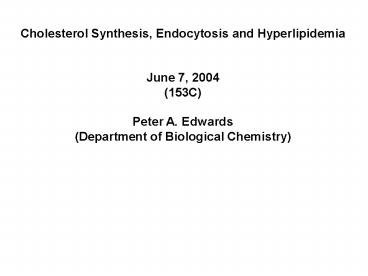Cholesterol Synthesis, Endocytosis and Hyperlipidemia - PowerPoint PPT Presentation
1 / 31
Title:
Cholesterol Synthesis, Endocytosis and Hyperlipidemia
Description:
Cholesterol Synthesis, Endocytosis and Hyperlipidemia June 7, 2004 (153C) Peter A. Edwards (Department of Biological Chemistry) Hyperlipidemia Total LDL HDL ... – PowerPoint PPT presentation
Number of Views:207
Avg rating:3.0/5.0
Title: Cholesterol Synthesis, Endocytosis and Hyperlipidemia
1
Cholesterol Synthesis, Endocytosis and
Hyperlipidemia June 7, 2004 (153C) Peter A.
Edwards (Department of Biological Chemistry)
2
Hyperlipidemia
Hyperlipidemia is linked to atherosclerosis,
MI/heart attack (50 fatal), diabetes. Metabolic
Syndrome often associated with TGsgt150 mg/dl.
NIH guidelines for treatment for high cholesterol
and/or triglycerides are at (http//www.nhlbi.nih
.gov/guidelines/cholesterol/atglance.htm).
3
Plasma Lipoproteins lipid transporters
Chylomicrons (lipid absorption)
LDL
(Metabolic syndrome) VLDL
HDL (protectivefemalesgtmales)
4
epitope
An epitope on apoB interacts with the LDL
receptor on the cell surface. Each LDL contains
1500 molecules of cholesteryl esters.
5
Development of Atherosclerosis
Accelerated by high levels of LDL or low levels
of HDL
6
Lumen
Plaque shoulder site of rupture
7
Angiography identifies lesions/ plaques.
Lesion/plaque (lesionslt80 occlusion are often
asymptomatic)
8
HDL
cholesterol
HDL
9
Lipid Absorption dietary fat is transported to
the liver by chylomicrons
Lipid hydrolysis and absorption
TG-rich core
10
Lipoprotein Metabolism hepatic lipids are
secreted as VLDL and subsequently converted to LDL
CE-rich
cholesterol
secretion
TG-rich
HDL
HDL
11
The LDL receptor and mutated LDL receptors
(Familial Hypercholesterolemia)
12
Endocytosis and cholesterol delivery the LDL
receptor
proton pump (acidification)
pH6
pHlt5
(signal)
13
How important is the LDL receptor in controlling
plasma LDL levels?
Familial Hypercholesterolemia
Autosomal dominant disease. Mutations in the
LDL receptor gene result in elevated plasma LDL
levels
Cholesterol (mg/dl)
Frequency LDL
total Normals 100-150
lt200 Heterozygote FH 1/500 persons 300-450
300-500 Homozygote FH 1/1,000,000
450-1100 500-1200 Afrikaner FH
(heteroz) 1/50 French Canadians gt1/500
(heterozygotes)
14
(No Transcript)
15
Endocytosis and cholesterol delivery the LDL
receptor
proton pump (acidification)
pH6
pHlt5
(signal)
16
Cholesterol/isoprenoid synthesis and metabolism
17
Statins competitive inhibitors of HMG-CoA
reductase activity.
Statins are structurally related to HMG-CoA, the
substrate of HMG-CoA reductase.
18
Statins inhibit hepatic HMG-CoA reductase
activity. The decrease in cholesterol synthesis
and cholesterol levels in the cell result in
increased expression of the LDL receptor and
HMG-CoA reductase.
Statins
19
Statins inhibit hepatic HMG-CoA
reductase/cholesterol synthesis and
increase LDL receptor expression.
20
Effect of Statin treatment on plasma cholesterol
(LDL)
(Heterozygous FH)
21
Cellular cholesterol concentrations control
nuclear SREBP levels and transcription of LDL
receptor and other SREBP-target genes
(Statin treatment)
High expression of the LDL receptor results in
increased clearance of plasma LDL into the liver
(high fat diet)
Low expression of the LDL receptor gene results
in decreased clearance of plasma LDL
22
Patients with the homozygous form of Familial
Hypercholesterolemia (FH) have mutations in both
LDL receptor genes. They have very high LDL
levels (500-1100 mg/dl) and may have heart
attacks before they are 10 years old. They die
at an early age of atherosclerosis. Will the
LDL levels of these FH patients decrease if they
are given Statins? How would you treat them to
lower their plasma LDL levels in order to reduce
their chances of having a heart attack?
23
(No Transcript)
24
Plasma cholesterol reduction in a patient with
homozygous Familial Hypercholesterolemia (gene
therapy!)
25
Summary Lipoprotein metabolism
26
HDL
cholesterol
HDL
27
Treatments for Hyperlipidemia
1.) Altered life style diet and exercise stop
smoking control diabetes. 2.) Exercise can
raise HDL and lower LDL levels. 3.) Drugs
a) HMG-CoA reductase inhibitors (Statins)
lower LDL cholesterol levels 25- 50.
b) Bile acid sequestrants lower LDL
levels. c) Niacin (Nicotinic acid) decreases
VLDL secretion (lowers TGs) and
increases HDL. d) Fibrates (PPARa agonists)
lower plasma TGs. e) Aspirin
Anti-thrombolitic (reduces blood clotting). f)
Thrombolytic therapy. eg. treatment with tissue
plasminogen activator (tPA) to dissolve the
blood clot/thrombi at the site of the
infarct. 4.) Surgery includes i. By-pass
surgery. ii. Angioplasty (balloon) /- stents.
After surgery, patients are routinely put
on Statins (to lower LDL cholesterol), aspirin
(to reduce thrombi), beta blockers and ACE
inhibitors (to reduce blood pressure and heart
contraction). iii. Heart
transplant (for patients with heart failure).
28
Primary Lipid Disorders
Familial defective apoB
FH (high LDL)
Abetalipoprotein- emia
(LPL deficiency)
(LPL deficiency) (high TGs)
29
MUTANT epitope
An epitope on apoB normally interacts with the
LDL receptor. A mutation at this site impairs
LDL clearance from the plasma.
30
Clathrin
31
Endocytosis and cholesterol delivery the LDL
receptor
Wolmans disease (Acid lipase defect)

